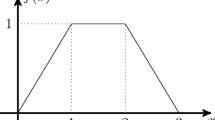Abstract
In this paper, we consider the stochastic mathematical programs with linear complementarity constraints, which include two kinds of models called here-and-now and lower-level wait-and-see problems. We present a combined smoothing implicit programming and penalty method for the problems with a finite sample space. Then, we suggest a quasi-Monte Carlo approximation method for solving a problem with continuous random variables. A comprehensive convergence theory is included as well. We further report numerical results with the so-called picnic vender decision problem.
Similar content being viewed by others
References
Anitescu M. (2005). On using the elastic mode in nonlinear programming approaches to mathematical programs with complementarity constraints. SIAM J. Optim. 15: 1203–1236
Bertsekas D.P. (1982). Constrained Optimization and Lagrange Multiplier Methods. Academic Press, New York
Birbil S.I., Gürkan G. and Listes O. (2006). Solving stochastic mathematical programs with complementarity constraints using simulation. Math. Oper. Res. 31: 739–760
Birge J.R. and Louveaux F. (1997). Introduction to Stochastic Programming. Springer, New York
Chen X. and Fukushima M. (2004). A smoothing method for a mathematical program with P-matrix linear complementarity constraints. Comput. Optim. Appl. 27: 223–246
Chen Y. and Florian M. (1995). The nonlinear bilevel programming problem: formulations, regularity and optimality conditions. Optimization 32: 193–209
Cottle R.W., Pang J.S. and Stone R.E. (1992). The Linear Complementarity Problem. Academic, New York
Facchinei F., Jiang H. and Qi L. (1999). A smoothing method for mathematical programs with equilibrium constraints. Math. Program. 85: 107–134
Facchinei F. and Pang J.S. (2003). Finite-Dimensional Variational Inequalities and Complementarity Problems, Part I. Springer, New York
Fischer A. (1992). A special Newton-type optimization method. Optimization 24: 269–284
Fletcher R., Leyffer S., Ralph D. and Scholtes S. (2006). Local convergence of SQP methods for mathematical programs with equilibrium constraints. SIAM J. Optim. 17: 259–286
Fukushima, M., Lin, G.H.: Smoothing methods for mathematical programs with equilibrium constraints. In: Proceedings of the ICKS’04, pp. 206–213. IEEE Computer Society (2004)
Fukushima M., Luo Z.Q. and Pang J.S. (1998). A globally convergent sequential quadratic programming algorithm for mathematical programs with linear complementarity constraints. Comput. Optim. Appl. 10: 5–34
Fukushima M. and Pang J.S. (1999). Convergence of a smoothing continuation method for mathematical problems with complementarity constraints. Ill-posed Variational Problems and Regularization Techniques. In: Théra, M. and Tichatschke, R. (eds) Lecture Notes in Economics and Mathematical Systems. vol. 477, pp 105–116. Springer, Heidelberg
Hu X. and Ralph D. (2004). Convergence of a penalty method for mathematical programming with equilibrium constraints. J. Optim. Theory Appl. 123: 365–390
Jiang H. and Ralph D. (2000). Smooth SQP methods for mathematical programs with nonlinear complementarity constraints. SIAM J. Optim. 10: 779–808
Kall P. and Wallace S.W. (1994). Stochastic Programming. Wiley, Chichester
Lin, G.H., Chen, X., Fukushima, M.: Smoothing implicit programming approaches for stochastic mathematical programs with linear complementarity constraints. Technical Report 2003-006. Department of Applied Mathematics and Physics, Graduate School of Informatics, Kyoto University, Kyoto, Japan (2003)
Lin G.H. and Fukushima M. (2005). A class of stochastic mathematical programs with complementarity constraints: Reformulations and algorithms. J. Ind. Manag. Optim. 1: 99–122
Lin G.H. and Fukushima M. (2005). A modified relaxation scheme for mathematical programs with complementarity constraints. Ann. Oper. Res. 133: 63–84
Lin G.H. and Fukushima M. (2006). Hybrid algorithms with active set identification for mathematical programs with complementarity constraints. J. Optim. Theory Appl. 128: 1–28
Lin G.H. and Fukushima M. (2003). New relaxation method for mathematical programs with complementarity constraints. J. Optim. Theory Appl. 118: 81–116
Lin G.H. and Fukushima M. (2005). Regularization method for stochastic mathematical programs with complementarity constraints. Eur. Ser. Appl. Ind. Math. Control Optim. Calculus Var. 11: 252–265
Luo Z.Q., Pang J.S. and Ralph D. (1996). Mathematical Programs with Equilibrium Constraints. Cambridge University Press, Cambridge
Niederreiter H. (1992). Random Number Generation and Quasi-Monte Carlo Methods. SIAM, Philadelphia
Outrata J.V., Kocvara M. and Zowe J. (1998). Nonsmooth Approach to Optimization Problems with Equilibrium Constraints: Theory, Applications and Numerical Results. Kluwer, Boston
Patriksson M. and Wynter L. (1999). Stochastic mathematical programs with equilibrium constraints. Oper. Res. Lett. 25: 159–167
Scheel H.S. and Scholtes S. (2000). Mathematical programs with complementarity constraints: Stationarity, optimality and sensitivity. Math. Oper. Res. 25: 1–22
Scholtes S. (2001). Convergence properties of a regularization scheme for mathematical programs with complementarity constraints. SIAM J. Optim. 11: 918–936
Shapiro A. (2006). Stochastic programming with equilibrium constraints. J. Optim. Theory Appl. 128: 221–243
Shapiro, A., Xu, H.: Stochastic mathematical programs with equilibrium constraints. modeling and sample average approximation. School of Industrial and System Engineering, Georgia Institute of Technology, Antalanta, Georgia, USA (2005)
Vajda S. (1972). Probabilistic Programming. Academic, New York
Xu H. (2006). An implicit programming approach for a class of stochastic mathematical programs with linear complementarity constraints. SIAM J. Optim. 16: 670–696
Author information
Authors and Affiliations
Corresponding author
Additional information
This paper is dedicated to Professor Alfred Auslender on the occasion of his 65th birthday.
This work was supported in part by the Scientific Research Grant-in-Aid from Japan Society for the Promotion of Science.
Rights and permissions
About this article
Cite this article
Lin, GH., Chen, X. & Fukushima, M. Solving stochastic mathematical programs with equilibrium constraints via approximation and smoothing implicit programming with penalization. Math. Program. 116, 343–368 (2009). https://doi.org/10.1007/s10107-007-0119-3
Received:
Accepted:
Published:
Issue Date:
DOI: https://doi.org/10.1007/s10107-007-0119-3
Keywords
- Stochastic mathematical program with equilibrium constraints
- Wait-and-see
- Here-and-now
- Smoothing implicit programming
- Quasi-Monte Carlo method




